

Notch signaling pathway. Structure of the ligand binding region of the human NOTCH-1 receptor Notch-mediated juxtacrine signal between adjacent cells.

Discovery[edit] In 1914, John S. Metcalfe's law. Two telephones can make only one connection, five can make 10 connections, and twelve can make 66 connections.
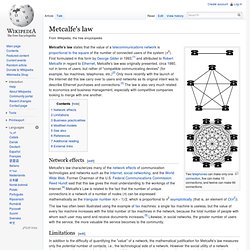
Metcalfe's law states that the value of a telecommunications network is proportional to the square of the number of connected users of the system (n2). First formulated in this form by George Gilder in 1993,[1] and attributed to Robert Metcalfe in regard to Ethernet, Metcalfe's law was originally presented, circa 1980, not in terms of users, but rather of "compatible communicating devices" (for example, fax machines, telephones, etc.)[2] Only more recently with the launch of the Internet did this law carry over to users and networks as its original intent was to describe Ethernet purchases and connections.[3] The law is also very much related to economics and business management, especially with competitive companies looking to merge with one another.
Network effects[edit] Limitations[edit] Business practicalities[edit] Modified models[edit] Feedback. "...'feedback' exists between two parts when each affects the other.
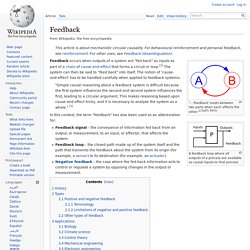
"[1](p53, §4/11) A feedback loop where all outputs of a process are available as causal inputs to that process "Simple causal reasoning about a feedback system is difficult because the first system influences the second and second system influences the first, leading to a circular argument. In this context, the term "feedback" has also been used as an abbreviation for: Jamming avoidance response. Two neighboring Eigenmannia perform the jamming avoidance response: When one fish with an electric discharge of 400 Hz encounters a second fish with the same frequency, one fish shifts its frequency upward and the other shifts its frequency downward.
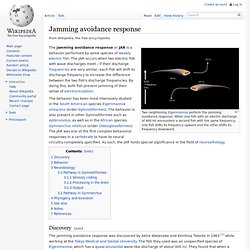
The jamming avoidance response or JAR is a behavior performed by some species of weakly electric fish. The JAR occurs when two electric fish with wave discharges meet – if their discharge frequencies are very similar, each fish will shift its discharge frequency to increase the difference between the two fish's discharge frequencies. By doing this, both fish prevent jamming of their sense of electroreception. The behavior has been most intensively studied in the South American species Eigenmannia virescens (order Gymnotiformes).
Signalling theory. Signals are given in contexts such as mate selection by females, which subjects the males' signals to selective pressure.
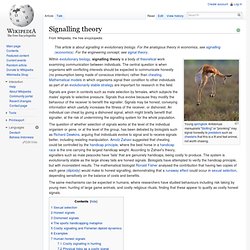
Self-governance. Self-governance is an abstract concept that applies to several scales of organization.

It may refer to personal conduct or family units but more commonly refers to larger scale activities, i.e., professions, industry bodies, religions and political units (usually referred to as Local Government), up to and including autonomous regions and/or others within nation-states who enjoy some sovereign rights. It falls within the larger context of governance and principles such as consent of the governed, and may involve non-profit organizations and corporate governance. It can be used to describe a people or group being able to exercise all of the necessary functions of power without intervention from any authority which they cannot themselves alter.
Generally when self-governance of nation-states is discussed, it is called national sovereignty – a concept important in international law. Self-regulation theory. Self-regulation theory or SRT is a system of conscious personal health management.
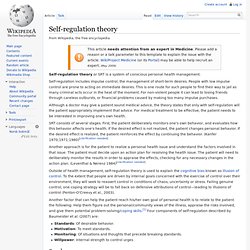
Self-regulation includes impulse control, the management of short-term desires. People with low impulse control are prone to acting on immediate desires. This is one route for such people to find their way to jail as many criminal acts occur in the heat of the moment. For non-violent people it can lead to losing friends through careless outbursts, or financial problems caused by making too many impulse purchases. Although a doctor may give a patient sound medical advice, the theory states that only with self-regulation will the patient appropriately implement that advice. SRT consists of several stages. Another approach is for the patient to realize a personal health issue and understand the factors involved in that issue. Illusion of control. The illusion of control is the tendency for people to overestimate their ability to control events, for instance to feel that they control outcomes that they demonstrably have no influence over.[1] The effect was named by psychologist Ellen Langer and has been replicated in many different contexts.[2] It is thought to influence gambling behavior and belief in the paranormal.[3] Along with illusory superiority and optimism bias, the illusion of control is one of the positive illusions.

Although, the idea of illusion of control has been studied prior to Langer. Psychological theorists have consistently emphasized the importance of perceptions of control over life events. One of the earliest instances of this is when Adler[who?] Argued that people strive for proficiency in their lives. Heider[who?] The illusion might arise because people lack direct introspective insight into whether they are in control of events. Personal identity. What does it take for individuals to persist from moment to moment—or in other words, for the same individual to exist at different moments?

Generally, it is the unique numerical identity of persons through time.[3][4] That is to say, the necessary and sufficient conditions under which a person at one time and a person at another time can be said to be the same person, persisting through time. Emotional self-regulation. Emotional self-regulation or regulation of emotion is the ability to respond to the ongoing demands of experience with the range of emotions in a manner that is socially tolerable and sufficiently flexible to permit spontaneous reactions as well as the ability to delay spontaneous reactions as needed.[1] It can also be defined as extrinsic and intrinsic processes responsible for monitoring, evaluating, and modifying emotional reactions.[2] Emotion self-regulation belongs to the broader set of emotion-regulation processes, which includes the regulation of one's own feelings and the regulation of other people's feelings.[3] Theory[edit] Process model[edit] The process model of emotion regulation is based upon the modal model of emotion.
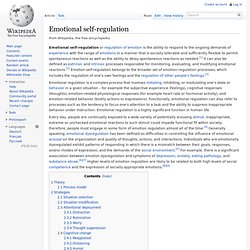
The modal model of emotion suggests that the emotion generation process occurs in a particular sequence over time. This sequence occurs as follows: Situation selectionSituation modificationAttentional deploymentCognitive changeResponse modulation.[11]